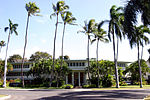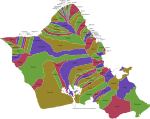Palm Circle
Buildings and structures completed in 1907Buildings and structures in HonoluluForts on the National Register of Historic Places in HawaiiHistoric districts on the National Register of Historic Places in HawaiiNRHP infobox with nocat ... and 3 more
National Historic Landmarks in HawaiiNational Register of Historic Places in HonoluluWorld War II on the National Register of Historic Places in Hawaii

Palm Circle or the Pineapple Pentagon, is a historic portion of Fort Shafter in Honolulu, Hawaii. Designated a National Historic Landmark in 1987, it housed the headquarters of the commanding general and his staff, U.S. Army forces, Pacific Ocean Areas, during World War II. By 1944 this command was responsible for the supply and administration of all U.S. Army personnel in the Central and South Pacific, and from 1943 to 1945, carried out logistical planning for the invasions of the Gilberts, Marshalls, Marianas, Guam, Palau, and Okinawa.
Excerpt from the Wikipedia article Palm Circle (License: CC BY-SA 3.0, Authors, Images).Palm Circle
Maalahi Street, Honolulu Moanalua Gardens
Geographical coordinates (GPS) Address Nearby Places Show on map
Geographical coordinates (GPS)
| Latitude | Longitude |
|---|---|
| N 21.35 ° | E -157.89027777778 ° |
Address
Maalahi Street 1399
96819 Honolulu, Moanalua Gardens
Hawaii, United States
Open on Google Maps







